英语一般疑问句(语法)
英语中一般疑问句
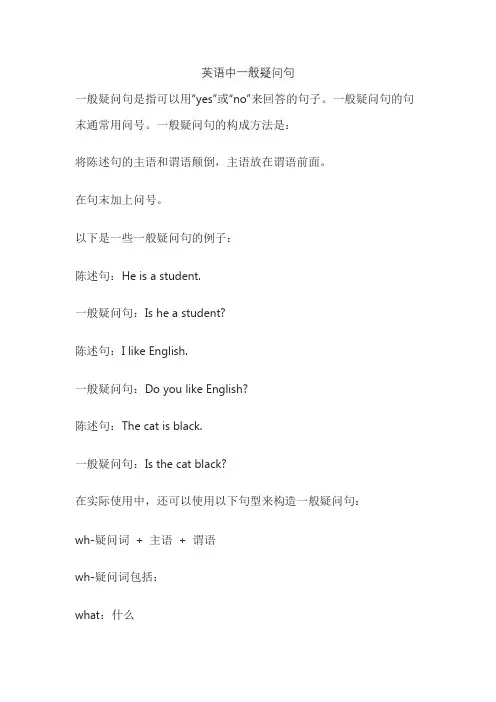
英语中一般疑问句
一般疑问句是指可以用“yes”或“no”来回答的句子。
一般疑问句的句末通常用问号。
一般疑问句的构成方法是:
将陈述句的主语和谓语颠倒,主语放在谓语前面。
在句末加上问号。
以下是一些一般疑问句的例子:
陈述句:He is a student.
一般疑问句:Is he a student?
陈述句:I like English.
一般疑问句:Do you like English?
陈述句:The cat is black.
一般疑问句:Is the cat black?
在实际使用中,还可以使用以下句型来构造一般疑问句:
wh-疑问词+ 主语+ 谓语
wh-疑问词包括:
what:什么
who:谁
where:在哪里
when:什么时候
why:为什么
how:如何
以下是一些使用wh-疑问词构造一般疑问句的例子:陈述句:The book is on the table.
一般疑问句:What is on the table?
陈述句:The man is my father.
一般疑问句:Who is your father?
陈述句:I went to the park yesterday.
一般疑问句:When did you go to the park?
陈述句:I like to eat apples.
一般疑问句:Why do you like to eat apples?
陈述句:I can run very fast.
一般疑问句:How fast can you run?。
英语常见疑问句
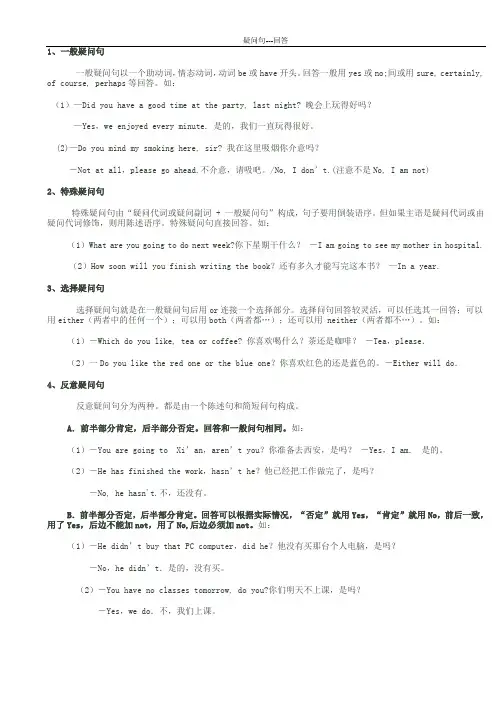
疑问句---回答1、一般疑问句一般疑问句以一个助动词,情态动词,动词be或have开头。
回答一般用yes或no;间或用sure, certainly, of course, perhaps等回答。
如:(1)—Did you have a good time at the party, last night? 晚会上玩得好吗?—Yes,we enjoyed every minute. 是的,我们一直玩得很好。
(2)—Do you mind my smoking here, sir? 我在这里吸烟你介意吗?-Not at all,please go ahead.不介意,请吸吧。
/No, I don’t.(注意不是No, I am not)2、特殊疑问句特殊疑问句由“疑问代词或疑问副词 + 一般疑问句”构成,句子要用倒装语序。
但如果主语是疑问代词或由疑问代词修饰,则用陈述语序。
特殊疑问句直接回答。
如:(1)What are you going to do next week?你下星期干什么?-I am going to see my mother in hospital.(2)How soon will you finish writing the book?还有多久才能写完这本书?—In a year.3、选择疑问句选择疑问句就是在一般疑问句后用or连接一个选择部分。
选择问句回答较灵活,可以任选其一回答;可以用either(两者中的任何一个);可以用both(两者都…);还可以用 neither(两者都不…)。
如:(1)-Which do you like, tea or coffee? 你喜欢喝什么?茶还是咖啡?-Tea,please.(2)一Do you like the red one or the blue one?你喜欢红色的还是蓝色的。
-Either will do.4、反意疑问句反意疑问句分为两种。
英语 疑问句 语法结构
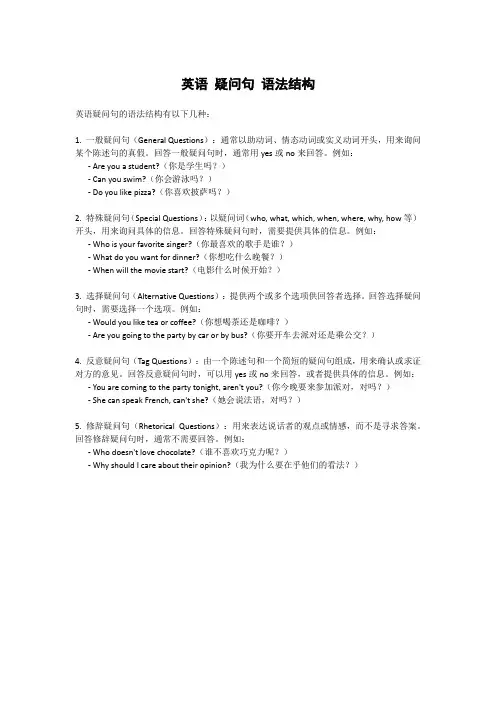
英语疑问句语法结构英语疑问句的语法结构有以下几种:1. 一般疑问句(General Questions):通常以助动词、情态动词或实义动词开头,用来询问某个陈述句的真假。
回答一般疑问句时,通常用yes或no来回答。
例如:- Are you a student?(你是学生吗?)- Can you swim?(你会游泳吗?)- Do you like pizza?(你喜欢披萨吗?)2. 特殊疑问句(Special Questions):以疑问词(who, what, which, when, where, why, how等)开头,用来询问具体的信息。
回答特殊疑问句时,需要提供具体的信息。
例如:- Who is your favorite singer?(你最喜欢的歌手是谁?)- What do you want for dinner?(你想吃什么晚餐?)- When will the movie start?(电影什么时候开始?)3. 选择疑问句(Alternative Questions):提供两个或多个选项供回答者选择。
回答选择疑问句时,需要选择一个选项。
例如:- Would you like tea or coffee?(你想喝茶还是咖啡?)- Are you going to the party by car or by bus?(你要开车去派对还是乘公交?)4. 反意疑问句(Tag Questions):由一个陈述句和一个简短的疑问句组成,用来确认或求证对方的意见。
回答反意疑问句时,可以用yes或no来回答,或者提供具体的信息。
例如:- You are coming to the party tonight, aren't you?(你今晚要来参加派对,对吗?)- She can speak French, can't she?(她会说法语,对吗?)5. 修辞疑问句(Rhetorical Questions):用来表达说话者的观点或情感,而不是寻求答案。
(完整)英语一般疑问句(语法)
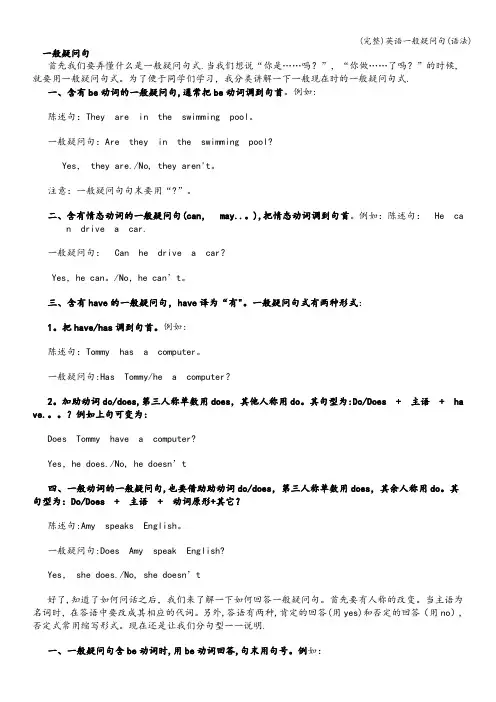
一般疑问句首先我们要弄懂什么是一般疑问句式.当我们想说“你是……吗?”,“你做……了吗?”的时候,就要用一般疑问句式。
为了便于同学们学习,我分类讲解一下一般现在时的一般疑问句式.一、含有be动词的一般疑问句,通常把be动词调到句首。
例如:陈述句:They are in the swimming pool。
一般疑问句:Are they in the swimming pool?Yes, they are./No, they aren't。
注意:一般疑问句句末要用“?”。
二、含有情态动词的一般疑问句(can,may..。
),把情态动词调到句首。
例如:陈述句: He can drive a car.一般疑问句:Can he drive a car?Yes,he can。
/No,he can’t。
三、含有have的一般疑问句,have译为“有"。
一般疑问句式有两种形式:1。
把have/has调到句首。
例如:陈述句:Tommy has a computer。
一般疑问句:Has Tommy/he a computer?2。
加助动词do/does,第三人称单数用does,其他人称用do。
其句型为:Do/Does + 主语+ ha ve.。
?例如上句可变为:Does Tommy have a computer?Yes,he does./No, he doesn’t四、一般动词的一般疑问句,也要借助助动词do/does,第三人称单数用does,其余人称用do。
其句型为:Do/Does + 主语+ 动词原形+其它?陈述句:Amy speaks English。
一般疑问句:Does Amy speak English?Yes, she does./No, she doesn’t好了,知道了如何问话之后,我们来了解一下如何回答一般疑问句。
首先要有人称的改变。
当主语为名词时,在答语中要改成其相应的代词。
【初中语法三】一般疑问句

三、一般疑问句一般疑问句是疑问句的一种。
它是只用yes(是)或no(否)来回答的句子。
其结构是:系动词be/助动词/情态动词+主语+其他成分通常回答为:肯定:Yes,+主语+提问的助动词.否定:No,+主语+提问的助动词的否定形式.如:1.Are you from Japan﹖你来自日本吗?Yes, I am./ No, I'm not.是的,我是/不,我不是。
2.Is her sister doing her homework now﹖她的姐姐正在做家庭作业吗?Yes, she is./ No, she isn't.是的,她正在做/不,她现在没做。
3.Does he work in a bank﹖他在银行工作吗?Yes, he does./ No, he doesn't.是的,他在银行工作。
/不,他没在银行工作。
4.Do you live near your school﹖你住在你学校附近吗?Yes, I do./ No, I don't.是的,我是住在学校附近/不,我没有5.Can you speak French﹖你会说法语吗?Yes, I can./ No, I can't.是的,我会/不,我不会。
6.May I go home now﹖我现在能回家吗?Yes, you may./ No, you mustn't.是的,你能/不,你不能。
1.将陈述句变为一般疑问句时,如句中有be 动词(am/ is/ are)时,可直接将它们提至主语前。
如主语为第一人称,应将其改为第二人称。
秘诀:一调二改三问号一调:即把句中的be或情态动词调到主语前;二改:改换主语称谓,即将句中的主语I\my \mines\we\our\ours等第一人称分别改为相应的第二人称you\your\ yours等;三问号:句末的句号改为问号。
如:I'm in Class 2Grade 1.我在一年级2班。
英语中的一般疑问句
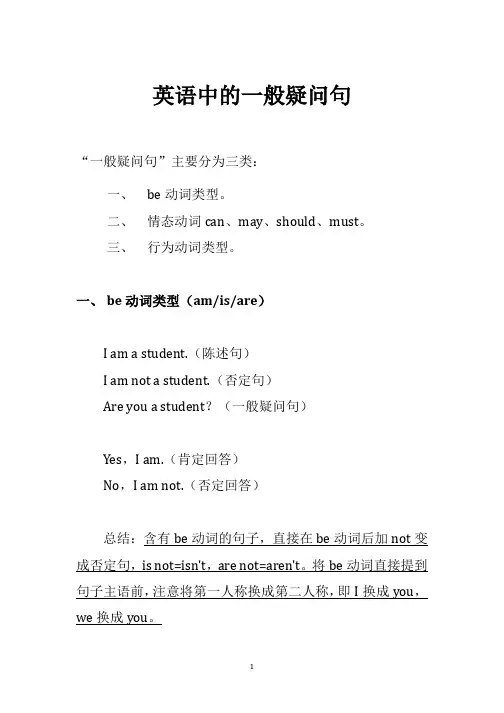
英语中的一般疑问句“一般疑问句”主要分为三类:一、be动词类型。
二、情态动词can、may、should、must。
三、行为动词类型。
一、be动词类型(am/is/are)I am a student.(陈述句)I am not a student.(否定句)Are you a student?(一般疑问句)Yes,I am.(肯定回答)No,I am not.(否定回答)总结:含有be动词的句子,直接在be动词后加not变成否定句,is not=isn't,are not=aren't。
将be动词直接提到句子主语前,注意将第一人称换成第二人称,即I换成you,we换成you。
二、情态动词类型(can/may/should/must)He can play basketball.(陈述句)He can not play basketball.(否定句)Can he play basketball?(一般疑问句)Yes,he can.(肯定回答)No,he can not.(否定回答)总结:含有情态动词的句子,变否定直接在情态动词后加not,变一般疑问句直接将情态动词提前。
三、行为动词类型I go to school by bike.(陈述句)I do not go to school by bike.(否定句)Do you go to school by bike?(一般疑问句)Yes,I do.(肯定回答)No,I do not.(否定回答)She goes to school by bike.(陈述句)She does not go to school by bike.(否定句)Does she go to school by bike?(一般疑问句)Yes,she does.(肯定回答)No,she does not.(否定回答)总结:行为动词变否定和一般疑问需要借助助动词do 或者does,当主语是第三人称单数时,助动词用does。
一般疑问句语法
一般疑问句语法
一、简介
英语疑问句能帮助人们和他人交流,它们通常要求对方回答,以便收
集更多的信息。
疑问句一般有两种类型:一种是一般疑问句,一种是
特殊疑问句。
二、一般疑问句
一般疑问句的句式是一个肯定句的反义句,构成时需要用到谓语动词,否定副词、助动词和谓语动词。
1. 谓语动词:
谓语动词在一般疑问句中是核心,可以用不同的形式表示,比如: be (am,is,are),do,have等助动词。
2. 否定词:
否定词用来构成句子的否定句式,比如:not,neither,nor,never等。
3. 助动词:
助动词用来表达不同种类的动作或状态,比如:do,does,did,have,has,had,can,could,will,would,shall,should等。
4. 谓语动词:
谓语动词的功能是表达句子的主要的动作或者状态,比如:go,come,walk,buy,sell,like,love,hate,believe,know等。
三、结论
英语疑问句分为一般疑问句和特殊疑问句两类,一般疑问句和肯定句
结构是一样的,只是含义反过来,而且还涉及许多英语中的词汇和语法,需要通过谓语动词、否定副词、助动词和谓语动词等等来构成句子,所以要正确理解并且掌握一般疑问句的用法,从而可以正确表达
自己的意思。
英语一般疑问句
疑问句(questions)指提出问题,请对方回答的句子。
疑问句句末要用问号。
按结构可分为四种:一般疑问句、特殊疑问句、选择疑问句、反意疑问句。
(一)一般疑问句1、一般疑问句概述一般疑问句(general questions),也可称为“yes/no” questions(是否型问句),因为它一般是由yes或no回答的,如:—Can you swim to the other side?你能游到对岸吗?—Yes, I can.是的,我能。
—No,I can’t.不,我不能。
—Have you locked the door?你锁门了吗?—Yes,I have.是的,锁了。
—No,I haven’t. 不,没有锁。
2一般疑问句的结构(1)基本的结构为:be/助动词/情态动词+主语+谓语/表语+(其他),句子要读升调,如:Are they your friends?他们是你的朋友吗?Does he go to school on foot?他是步行去上学吗?Will you be free tonight?你今晚有空吗?Can you play basketball?你会打篮球吗?(2)陈述句亦可用作一般疑问句,多用在非正式文体中,句末有问号,用升调,如:Somebody is with you?有人和你一起吗?He didn’t finish the work?他没有做完活吗?You are fresh from America,I suppose?我猜,你刚从美国回来吧?3、一般疑问句的答语(1)一般疑问句一般由yes或no来回答,如:—Are you tired?你累了吗?—Yes,I am.是的,累了。
—No, I’m not.不,不累。
—Does she do the cleaning?她扫除了吗?—Yes ,she does.是的,她打扫了。
—No,she doesn’t.不,她没打扫。
初中英语语法疑问句(一般疑问句、特殊疑问句)
• Mum: She likes biscuits very much.
• Millie: _W__h_y _do we need that big bag?
• Mum: Because we need to take lots of things
to Harbin.
B Asking ‘wh-’ questions
We use ‘wh-’ questions to ask for information about someone/something.
what----activity or thing which----thing or person who----person whose----possession when----time where----place why-----reason
flowers for your teachers?
Susan: No, I didn’t buy __a_n_y_ flowers, but I bought _so__m_e__ cards. Look!
Tom: Wow, how beautiful they are. Where did you buy them?
陈述句
简短的疑问句
He doesn’t need to work so late, does he ?
反意疑问句的基本结构有两种:一是:肯定 陈述句+简短的否定问句 ;二是:否定陈述 句+简短的肯定问句。简称“前肯后否,前 否后肯。”
He is a teacher , isn’t he ?
She didn’t go to school , did she ?
“你什么时候能完成作业?” “Tomorrow.” “明天。”
一般疑问句的定义
一般疑问句的定义一般疑问句是英语语法中的一种基本句式。
它用于询问某件事情是否属实或是否正确。
一般疑问句通常以助动词或be动词开头,后面跟主语和谓语动词的疑问形式。
例如,“Do you like coffee?”(你喜欢咖啡吗?),“Is it raining outside?”(外面在下雨吗?)。
一般疑问句的定义一般疑问句是用来询问某件事情是否属实或是否正确的句子,它通常以助动词或be动词开头,后面跟主语和谓语动词的疑问形式。
一般疑问句的目的是获得信息或确认信息的真实性。
一般疑问句的构成一般疑问句的构成通常包括以下几个部分:1. 助动词或be动词一般疑问句通常以助动词或be动词开头。
助动词可以是do、does、did、will、would、can、could、may、might、should、shall、must 等。
be动词可以是am、is、are、was、were等。
2. 主语主语是一般疑问句中的一个重要部分,它通常是一个名词、代词或名词短语。
主语通常位于助动词或be动词之后。
3. 谓语动词的疑问形式谓语动词的疑问形式通常是将动词原形改为动词第三人称单数形式(如果主语是第三人称单数),或者加上助动词do/does/did(如果主语不是第三人称单数)。
例如,“Do you like coffee?”(你喜欢咖啡吗?),“Does he like coffee?”(他喜欢咖啡吗?)。
一般疑问句的回答一般疑问句的回答通常是“yes”或“no”。
如果回答是“yes”,通常需要加上肯定的理由或解释。
如果回答是“no”,通常需要加上否定的理由或解释。
例如,“Do you like coffee?”(你喜欢咖啡吗?),“Yes, I do. It's my favorite drink.”(是的,我喜欢。
它是我最喜欢的饮料。
),“No, I don't. I prefer tea.”(不,我不喜欢。
- 1、下载文档前请自行甄别文档内容的完整性,平台不提供额外的编辑、内容补充、找答案等附加服务。
- 2、"仅部分预览"的文档,不可在线预览部分如存在完整性等问题,可反馈申请退款(可完整预览的文档不适用该条件!)。
- 3、如文档侵犯您的权益,请联系客服反馈,我们会尽快为您处理(人工客服工作时间:9:00-18:30)。
一般疑问句首先我们要弄懂什么是一般疑问句式。
当我们想说“你是……吗”,“你做……了吗”的时候,就要用一般疑问句式。
为了便于同学们学习,我分类讲解一下一般现在时的一般疑问句式。
一、含有be动词的一般疑问句,通常把be动词调到句首。
例如:陈述句:They are in the swimming pool.一般疑问句:Are they in the swimming poolYes, they are./No, they aren’t.注意:一般疑问句句末要用“”。
二、含有情态动词的一般疑问句(can, may...),把情态动词调到句首。
例如:陈述句: He can drive a car.一般疑问句: Can he drive a carYes,he can./No,he can’t.三、含有have的一般疑问句,have译为“有”。
一般疑问句式有两种形式:1.把have/has调到句首。
例如:陈述句:Tommy has a computer.一般疑问句:Has Tommy/he a computer2.加助动词do/does,第三人称单数用does,其他人称用do。
其句型为:Do/Does + 主语+ have...例如上句可变为:Does Tommy have a computerYes,he does./No, he doesn’t四、一般动词的一般疑问句,也要借助助动词do/does,第三人称单数用does,其余人称用do。
其句型为:Do/Does + 主语+ 动词原形+其它陈述句:Amy speaks English.一般疑问句:Does Amy speak EnglishYes, she does./No, she doesn’t好了,知道了如何问话之后,我们来了解一下如何回答一般疑问句。
首先要有人称的改变。
当主语为名词时,在答语中要改成其相应的代词。
另外,答语有两种,肯定的回答(用yes)和否定的回答(用no),否定式常用缩写形式。
现在还是让我们分句型一一说明。
一、一般疑问句含be动词时,用be动词回答,句末用句号。
例如:-Is Mary your sister-Yes, she is. / No, she isn’t.(缩写)二、一般疑问句含有情态动词(can, may, should等)时,用情态动词回答。
例如:-May I come in-Yes, you may. / No, you can’t. /Come in, please.三、一般疑问句含有have(译为“有”)时,有两种回答方式。
1.直接用have/has回答。
例如:-Have they any pictures-Yes, they have. / No, they haven’t.2.用助动词do/does回答。
例如:-Does Millie smoke-Yes, she does. / No, she doesn’t.四、一般动词的一般疑问句回答时也用助动词。
例如:-Do the workers live in London-Yes, they do. / No, they don’t.一、一般疑问句二、一般疑问句也可称为“yes /no questions”,因这种问句通常用yes / no来回答,相当于汉语中的“……吗”其语序是:系动词be /助动词/情态动词+主语+其他成分如:三、Are you from Japan四、Yes ,I am./ No, I'm not.五、Is her sister doing her homework now六、Yes ,she is./ No ,she isn't.七、Does he work in a bank八、Yes ,he does./ No, he doesn't.九、Do you live near your school十、Yes ,I do./ No,I don't.十一、Can you speak French十二、Yes, I can./ No, I can't.十三、May I go home now十四、Yes ,you may./ No ,you mustn't.十五、注意:十六、1.将陈述句变为一般疑问句时,如句中有be 动词(am is are …)时,可直接将它们提至主语前。
如主语为第一人称,应将其改为第二人称。
如:十七、I'm in Class 2Grade 1.→十八、Are you in Class 2,Grade 1十九、We're watching TV.→二十、Are you watching TV二十一、2.陈述句中有情态动词(can may must …)时,也可直接将它们提至主语前,即可成为一般疑问句。
如:二十二、He can swim now.→二十三、Can he swim now二十四、The children may come with us.→ May the children come with us二十五、3.陈述句中只有一个实义动词作谓语且其时态为一般现在时,变为一般疑问句时要在句首加do或does 主语后的实义动词用原形。
如:二十六、I like these animals.→二十七、Do you like these animals二十八、She wants to go to the movies.→ Does she want to go to the movies 二十九、4.一般疑问句一般读升调(↑)三十、5.一般疑问句有时不用yes或 no 回答。
如:三十一、Are they in town now三十二、I think so.三十三、May I sit here三十四、Certainly.三十五、Does he like soccer三十六、Sorry, I don't know.一般疑问句练习情况1: Be(是) am is are先用be的适当形式填空然后按照要求变换句型l I ____ a teacher.一般疑问句:_______________________________肯定回答:____________________________否定回答:____________________________l You _____ a worker.一般疑问句:_______________________________肯定回答:____________________________否定回答:____________________________l He ____ a doctor.一般疑问句:_______________________________肯定回答:____________________________否定回答:____________________________l ______ she a student陈述句:_______________________________肯定回答:____________________________否定回答:____________________________l ______ we happy陈述句:_______________________________肯定回答:____________________________否定回答:____________________________l You _____ good workers.一般疑问句:_______________________________肯定回答:____________________________否定回答:____________________________l They _____ workers.一般疑问句:_______________________________肯定回答:____________________________否定回答:____________________________l ______ (它是) an apple.一般疑问句:_______________________________肯定回答:____________________________否定回答:____________________________情况2:have(是) have(第一二人称单复数及第三人称复数) has(第三人称单数)l I _____ three books.一般疑问句:_______________________________肯定回答:____________________________否定回答:____________________________l You _____ a car.一般疑问句:_______________________________肯定回答:____________________________否定回答:____________________________He ____ many trees.一般疑问句:_______________________________肯定回答:____________________________否定回答:____________________________She ____ five beautiful dresses.一般疑问句:_______________________________肯定回答:____________________________否定回答:_________________________________________(我们有) a television陈述句:_______________________________肯定回答:____________________________否定回答:____________________________They _____ a house in Shenzhen.一般疑问句:_______________________________肯定回答:____________________________否定回答:____________________________情况3.情态动词cancould为can的过去式,都能表示能,或者请求别人的许可。
在表示请求时,过去式不代表过去时态,而是使得语气更加委婉。
I can speak English.我能说英语。
